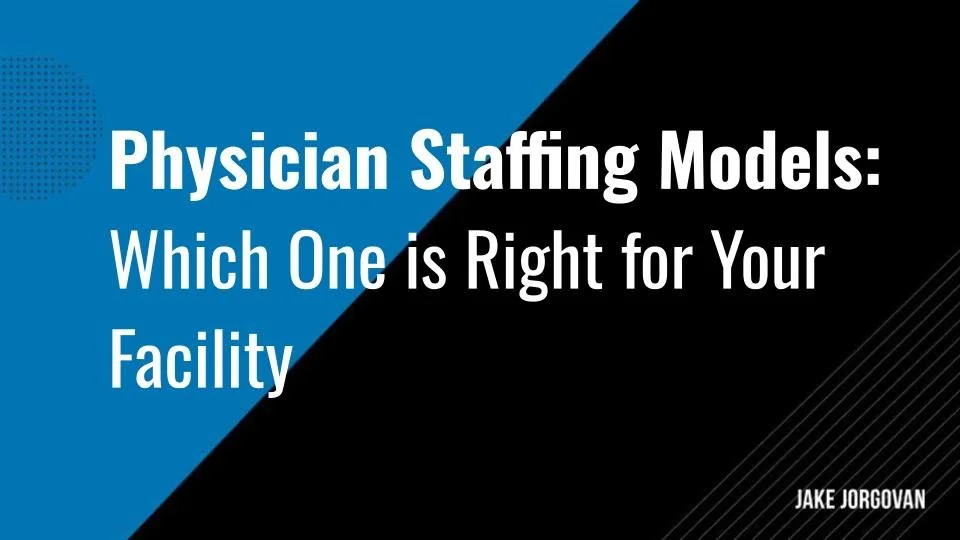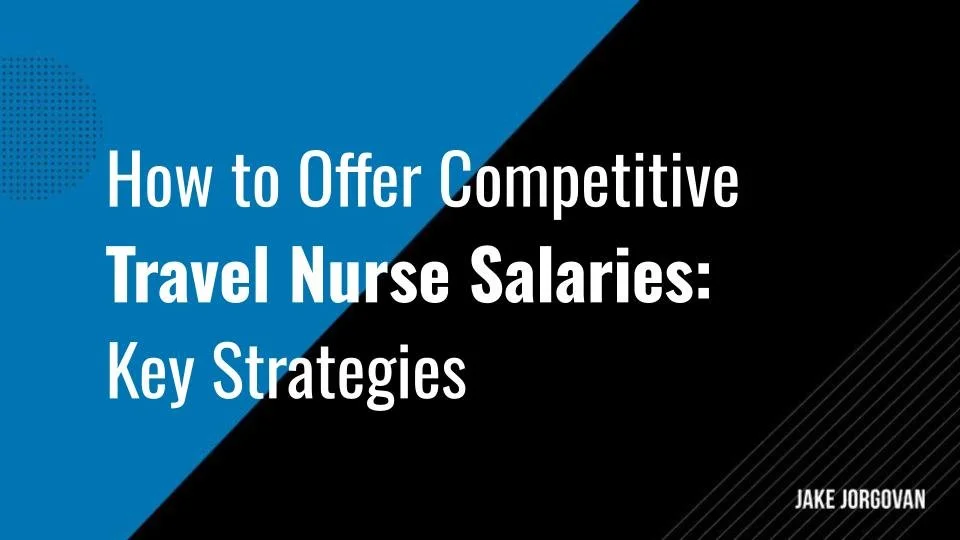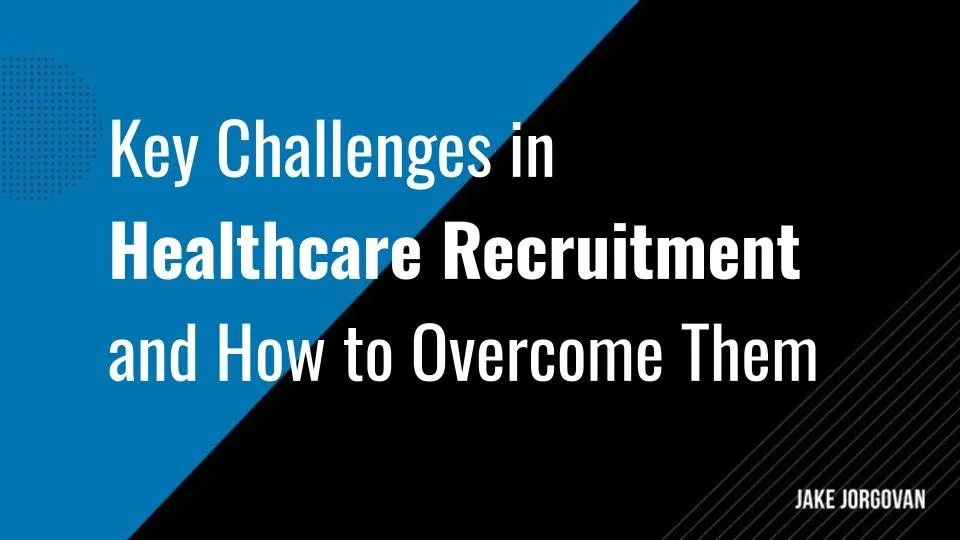Nurse Recruitment and Staffing By the Numbers: 20 Key Stats and Insights
The landscape of nurse recruitment and staffing is undergoing significant transformations, shaped by emerging challenges and evolving market dynamics.
This sector is critical for delivering essential healthcare services, yet it faces hurdles such as increasing retirements, high staff stress levels, and evolving healthcare demands.
This article will discuss the key stats and practical insights impacting nurse staffing and recruitment efforts.
Keep reading to use these stats and invaluable insights effectively as your organization progresses.
Nurse Recruitment and Staffing Industry Overview
There’s a lot of demand for nurses out there in a wide range of areas. The image below shows some of the main places where nurses work, from hospitals to outpatient care centers and more:
The following statistics provide a comprehensive overview of current trends in the industry, from the rise of travel nursing to the strategic use of alternative staffing solutions and the impact of technological advancements on nurse recruitment efforts.
These valuable insights will help you understand the current state and future directions of recruiting nurses, which are crucial for planning and policy-making in healthcare systems.
Let's take a closer look at these 10 statistics about nurse recruitment and staffing:
1. Nurse and Physician Early Retirement: Up to 71% of experienced nurses and physicians plan for early retirement due to stress and burnout from the COVID-19 pandemic. This is exacerbating the existing shortage of medical staff and increasing demand for temporary and locum nurses.
2. Market Growth and Financial Projections: The global healthcare staffing market is expected to grow significantly, reaching USD 42.37 billion in 2024 with a compound annual growth rate (CAGR) of 6.80%. This growth is driven by increased healthcare expenditures, the rising burden of chronic diseases, and strategic initiatives from major market players.
3. High Demand for Travel Nurses: The travel nurse staffing segment dominated the market with a share of 39.55% in 2022, and it is expected to be the fastest-growing segment, driven by high pay, travel opportunities, and short-term assignments.
4. Job Growth Rate for Nurses: The job growth rate for registered nurses is projected at 6% through 2031. This highlights the ongoing demand and opportunities within the profession.
5. Reliance on Alternative Staffing Solutions: There is an increasing reliance on alternative staffing solutions, such as travel nurses and international nurse staffing agencies, to fill gaps and manage safe and adequate staffing levels.
6. Challenges in Healthcare Recruitment: 47% of healthcare HR teams report struggling to find talent. This highlights significant recruitment challenges within the industry.
7. Staffing Provided Career Opportunities: In 2023, staffing provided job and career opportunities, including continuous learning opportunities, for about 13 million employees. This indicates the pivotal role of staffing agencies in the healthcare sector, as well as a growing focus on employee satisfaction.
8. Increasing Number of Hospitals: Last year, over 300 urgent care facilities were built. The growing number of healthcare facilities, driven by investments in medical infrastructure, is leading to higher demand for skilled nurses.
9. Tight Talent Pools as a Challenge: 56% of staffing agencies identify tight talent pools as their main hiring challenge. This points to significant issues in sourcing skilled candidates.
10. Weekly Payment Preferences in Staffing: 67% of U.S. staffing agencies offer weekly payments and reflect preferences in the industry's compensation practices.
Nurse Recruitment and Staffing Challenges
In 2024, the nurse recruitment and staffing industry is facing several significant challenges, including:
11. Shortage of Skilled Professionals: There's a widespread shortage of skilled healthcare professionals, including qualified nurses, which is exacerbated by the high competition in the healthcare recruitment space. On average, healthcare recruiters manage 61 open roles at any given time, and the average time to fill these positions is around 49 days. This is considerably longer than the average across other industries. The graphic below highlights this nursing shortage:
12. Highly Competitive Market for Talent: The healthcare staffing industry is becoming intensely competitive, and the nursing profession is no exception. Hiring companies are now offering substantial signing bonuses to attract top talent. Moreover, potential candidates are looking for more than just a competitive salary; they expect flexible work environments and a strong work-life balance. This heightens the competition for qualified candidates.
13. Increased Candidate Expectations: 76% of modern job seekers expect a highly personalized hiring experience. They also want quick responses to inquiries and continuous updates throughout the recruitment process. Meeting these expectations requires the use of advanced recruitment technologies like AI to enhance the candidate experience and streamline the hiring process.
14. Demand for Flexible Work Arrangements: Since the pandemic, candidate priorities have shifted towards flexible work arrangements. In fact, 93% of people want flexible schedules. This shift requires companies to rethink their work models and highlight their efforts to promote work-life balance, personal growth, and employee satisfaction to attract new nurses and retain current staff.
15. Retention Challenges Amidst Changing Demographics: The nursing workforce is aging, with a significant portion expected to retire in the coming years. This demographic shift is creating a vacuum that is challenging to fill with new graduates who may not yet have the necessary experience. Effective strategies are needed to manage this transition and ensure the delivery of quality care.
Each of these challenges necessitates a strategic approach, which includes leveraging technology, improving candidate engagement and experience, and adopting flexible working conditions. These nurse recruitment strategies are crucial for healthcare organizations to attract and retain the talent necessary to meet the growing healthcare demands.
The Financial Strain of Nurse Turnover
Nurse turnover imposes significant financial burdens on healthcare institutions, affecting both operational efficiency and patient care.
16. National RN Turnover Rate: The turnover rate for staff Registered Nurses (RNs) decreased by 4.6% in 2023, resulting in a national average of 18.4%. This rate varies by hospital size, ranging from 5.6% to 38.8%.
17. Cost Per RN Turnover: The average cost of nurse turnover is estimated to be $56,300 per RN. For the average hospital, this can equate to roughly $3.9 to $5.8 million in losses per year.
18. Impact on Patient Care: Higher RN turnover is directly linked to increased patient falls. Hospitals with lower turnover rates had fewer falls on average, leading to annual savings of approximately $105,000 for hospitals with 100–200 beds and about $616,000 for those with 400–500 beds.
19. Early Career Turnover: Approximately 34% of newly hired RNs leave within one year. Turnover rates decrease to 11.9% for nurses with over five years of tenure and 9.9% for those with over ten years.
20. Global Perspective: A meta-analysis of 21 studies involving 213,314 nurses from 14 countries found that nurse turnover rates range from 8% to 36.6%, with a global combined rate of 16%.
Salary Pressures and Compensation Gaps
Compensation disparities across regions and roles contribute to challenges in nurse recruitment and retention.
21. National Average Salary: The median annual wage for registered nurses was $86,070 in May 2023.
22. State Variations: California offers the highest average RN salary at $125,340 per year ($60.26 per hour), compared to the national average of $77,600 per year.
23. Salary expectations: 75% of nurses feel underpaid.
24. Cost of Living Adjustments: When adjusted for cost of living, RN hourly wages vary significantly. For instance, California's adjusted wage is $49.22, while Minnesota's is $48.45.
25. Recent Salary Increases: Staff nurses saw an average annual income increase to $89,200 in 2024, a $4,300 rise from the previous year, though this is a smaller increase compared to prior years.
Nursing School Bottlenecks & Licensing Delays
Educational and regulatory challenges hinder the entry of new nurses into the workforce.
26. Rejected Applicants: U.S. nursing schools turned away 65,766 qualified applications from baccalaureate and graduate nursing programs in 2023 due to insufficient faculty, clinical sites, classroom space, and budget constraints.
27. Licensing Exam Pass Rates: Florida reported the lowest nursing exam pass rate in the U.S. in 2024, exacerbating existing nurse shortages with a 7.8% vacancy rate, translating to more than 16,000 unfilled nursing positions.
28. International Recruitment: In the UK, one in four NHS nurses is recruited from abroad, highlighting a reliance on international staff due to domestic training inadequacies.
29. Gender Representation: The number of male nurses has nearly doubled over the past 25 years, yet they remain a minority in the field, comprising about 14-16% of the nursing workforce today.
Nurse Burnout and Mental Health Crisis
Workplace conditions contribute to high levels of stress and burnout among nurses, impacting retention and patient care.
30. Staffing Challenges: 41% of nurse managers reported an increase in open positions over the previous 12 months, though this is down from 57% in the prior year. Additionally, 32% of respondents experienced little staffing change, up from 19% the previous year.
31. Job satisfaction: 40% of nurses don’t love their jobs, and 62% of them are concerned about the future of nursing.
32. Workplace Safety Concerns: Nearly 1 in 4 nurses report not feeling safe at work, contributing to job dissatisfaction and turnover.
33. Early Career Attrition: In the UK, there has been a 43% increase in nurses leaving the profession within ten years of registration and a 67% rise within five years, indicating significant early career burnout.
34. Impact on Health Reforms: The early departure of nurses poses risks to healthcare system reforms, with experienced nurses leaving and being replaced by less experienced staff, potentially affecting patient care quality.
Nurse Recruitment and Staffing Future Outlook and Predictions
Several key trends and challenges shape the future outlook for the nurse recruitment and staffing industry in 2024 and beyond.
This points to an environment of opportunity and adaptation for healthcare organizations.
35. Applicant Tracking Systems (ATS) Adoption: While Applicant Tracking Systems have revolutionized hiring, their adoption varies. A study highlighted that over 90% of hospitals and healthcare institutions implementing such systems have seen a 20% average reduction in time-to-hire.
36. Expansion of Telehealth Services: The continued growth of telehealth is transforming care delivery, significantly impacting staffing as more professionals skilled in virtual care are needed. This expansion creates demand for telehealth-competent professionals and also reshapes where and how healthcare services are delivered. This necessitates adaptive staffing solutions.
37. Integration of Artificial Intelligence and Automation: AI and automation are set to penetrate healthcare industry practices further. By 2030, 10% of nurses’ tasks will be performed by AI. This will streamline operations from patient care to administrative tasks. This technological integration demands that healthcare professionals adapt to new tools and also develop skills in utilizing AI-driven data analytics for enhanced patient outcomes.
38. Growing Demand for Specialized Skills: Specialized areas such as geriatrics, mental health, and chronic disease management are seeing increased demand. This requires targeted recruitment and nurse retention strategies to attract professionals with specific expertise while holding onto current nursing staff. This ensures healthcare providers can effectively meet diverse patient needs and meet organizational goals.
39. Diversity and Inclusion in Workforce: There's an increasing focus on enhancing diversity within nursing teams, which are recognized for improving patient outcomes and creating a more inclusive service environment. Recruitment materials and strategies will need to evolve to attract a pool of candidates that reflects the diverse demographics of the communities they serve.
40. Flexible Staffing Models: With shifting workforce preferences, particularly after the COVID-19 pandemic, there's a rising demand for flexible work models. Healthcare organizations are thus moving towards more fluid staffing arrangements, such as contract work, part-time roles, and locum tenens, to accommodate this change and attract top talent.
These trends indicate a dynamic period ahead for nurse recruitment and staffing that requires proactive adaptation and strategic planning by healthcare organizations to meet the changing demands of the healthcare sector.
How to Make Use of These Stats
Understanding these statistics is the first step, but applying them effectively is what drives real change in nursing talent recruitment and staffing.
If you're managing hiring processes, these invaluable insights can help you anticipate workforce shortages, refine job offerings, and adopt staffing models that align with industry trends. Recognizing the demand for travel nurses, for instance, allows organizations to offer competitive pay structures and flexible work arrangements to attract top talent.
Healthcare institutions can also use these stats to improve their recruitment strategies. If candidate expectations are rising, investing in AI-driven hiring tools can streamline the recruitment process and improve the candidate experience. Today, nurse turnover rates remain far higher than pre-pandemic levels, and the nurse vacancy rate is also dangerously high, with over 75% of hospitals reporting rates higher than 10%.
Implementing AI can help address these challenges by efficiently matching candidates to roles and improving retention rates.
Additionally, with a growing focus on long-term retention, organizations should consider job satisfaction, professional growth programs, mentorship initiatives, and better work-life balance policies to attract high-quality candidates, reduce turnover, and maintain a stable workforce.
Ultimately, these numbers serve as a guide for making informed, data-driven decisions. Whether it's adjusting staffing levels based on projected job growth or preparing for demographic shifts in the workforce, a proactive approach ensures that healthcare facilities remain fully staffed with nursing talent and capable of delivering high-quality patient care.
Prepare for the Future of the Nurse Recruitment and Staffing Industry
In today's healthcare sector, the right approach to nurse recruitment, retention, and staffing is more important than ever.
Our analysis highlights a significant gap between the demand for nursing professionals and the available workforce.
Innovative solutions, such as competitive compensation, flexible scheduling, and enhanced professional development opportunities, are vital.
As we move forward, healthcare institutions must prioritize these strategies to sustain patient care quality and support our essential nursing workforce.

































